
Related
Millions of voters will be using electronic voting machines for the first time in upcoming elections and questions about their security are rife. We speak with computer science professor Dan Wallach and author Bev Harris. [Includes transcript]
Click here to read to full transcript Many people believe that the last presidential election was stolen by the Supreme Court. Voting rights activists think the next election could be stolen at the ballot box. Millions of voters will be using electronic voting machines for the first time in upcoming elections and questions about their security are rife.
Hundreds of computer scientists say electronic touchscreen voting machines could allow for massive election fraud. Already, malfunctioning software has caused confusion or possibly faulty vote tallies in races across the country. And a recent study out from Johns Hopkins researchers says that AccuVote machines are vulnerable to hackers, multiple votes and vote-switching.
The machines are built by Diebold Voting Systems of McKinney, Texas and used in a third of the precincts where electronic voting is already in place. Diebold also has extensive ties to the Republican Party. Company officials say they do not know whether the code examined by the Johns Hopkins researchers was used in actual elections.
In response to the Johns Hopkins report, Maryland Governor Robert Ehrlich postponed a nearly 56 million dollar contract with Diebold for 11,000 voting machines. A private consultant is now reviewing the technology behind Dieboldís touchscreen machines.
The proliferation of electronic voting machine contracts comes in the wake of the 3.9 billion dollar Help America Vote Act, approved by Congress last November. The legislation requires tougher security, usability and accuracy standards. The Act also mandates that all voting systems be updated by 2006 and allocates millions for purchase of new electronic machines.
We attempted to reach representatives from Diebold and from the Federal Elections Commission–neither returned our phone calls.
- Bev Harris, author of Black Box Voting: Ballot-Tampering in the 21st Century, who uncovered the public internet site where Diebold’s source code was posted.
- Dan Wallach, professor of computer science at Rice University and co-author of the Johns Hopkins report, “Analysis of an Electronic Voting System”
TRANSCRIPT
AMY GOODMAN: Well, many people say the last presidential election was stolen by the Supreme Court. Voting rights activists say the next election could be stolen at the ballot box. Millions of voters will be using electronic voting machines for the first time, and questions about their security are rife. Hundreds of computer scientists say electronic touch-screen voting machines could allow for massive election fraud. Already malfunctioning software has caused confusion or possibly faulty vote tallies in races across the country.
A recent study out of Johns Hopkins University says that Accu-Vote machines are vulnerable to hackers, multiple votes and vote-switching. The machines are built by Diebold Election Systems of McKinney, Texas and used in a third of the precincts where electronic voting is already in place. Diebold also has extensive ties to the Republican Party. Company officials say they don’t know whether the code examined by Johns Hopkins researchers was used in actual elections. In response to the Johns Hopkins report, Maryland governor Robert Ehrlich postponed a nearly $56 million contract with Diebold for 11,000 more voting machines. A private consultant is now reviewing the technology behind Diebold’s touch screen machines. The proliferation of electronic voting machine contracts comes in the wake of the $3.9 billion “Help America Vote” Act, approved by Congress last November. The legislation requires tougher security, usability and accuracy standards. The act also mandates all voting systems be updated by 2006 and allocates millions of dollars for purchase of new electronic machines.
We attempted to reach representatives from Diebold and from the Federal Elections Commission; neither returned our phone calls. But joining us instead, Dan Wallach, professor of computer science at Rice University, co-author of the Johns Hopkins report, called “Analysis of an electronic voting system;” and Beth Harris, author of “Black box voting, ballot tampering in the 21st century.” She uncovered the public Internet site where Diebold’s source code was posted.
Let’s start with Dan Wallach. Can you tell us what the Johns Hopkins University report found?
DAN WALLACH: Sure. It’s a pleasure to be here today. We found several interesting things when we were looking at Diebold’s source code. We were focusing on the source code for the touch-screen terminals, not the rest of the system. But what we found was very disturbing. You use the “smart cards”—these are credit card-sized plastic cards—when you walk into the polling place, somebody hands you one of these things, and you shove it into the computer, type your pin [code], and that’s supposed to only allow to you vote once. But the way the computer interacts with the “smart cards” is actually very trivial to forge. So anybody could manufacture the counterfeit cards and the machine would not be able to distinguish the real ones from the ones that you brought in yourself. And that means any voter could cast as many ballots as they’d like. Doesn’t take too much imagination to see where that can cause problems.
AMY GOODMAN: Explain that one more time. How can they cast as many votes as they want? I think this has hardly been covered in this country, and as we move into this election, people are just beginning to pay attention.
DAN WALLACH: Right. So to be clear, you can make your own smart card. And the smart card that you program yourself, these things, by the way, only cost a couple of dollars to purchase. Then you can program your smart card when the voting machine sends it a message that says, okay, you should be cancelled now, it just ignores that message. Thus as long as you can stand there in the privacy of the voting place, you can cast as many ballots as you have time to punch in before you start arousing suspicion. Maybe that means you can cast ten votes, maybe you can cast 20 votes, I don’t know how fast you can press the buttons.
AMY GOODMAN: Now what about the criticism of the report by Diebold that you didn’t actually have the, what, right source code?
DAN WALLACH: Yes. So this is a very…
AMY GOODMAN: And what does that mean for people who are not computer literate.
DAN WALLACH: OK, sure. So source code is what programmers write. It’s in a programming language like C or C plus plus, and in addition to instructions that tell the computer how to work, you can put commentary in the code that explains what you’re thinking, what you’re planning on doing next. It’s crib notes to yourself so you know what you’re doing. Well, the files that Diebold left on their website that we were able to analyze have all of their source code to the voting terminal and to other things. And not just-there are dates in there, you can see that with stuff we looked at was dated February, March of 2002 but we have like two years worth of history. We could turn the clock back and see what their source code looked like at any point in that time period.
AMY GOODMAN: And What does that prove?
DAN WALLACH: Well, so the code that we looked at was almost certainly, if it wasn’t the real code that was used in the November 2002 elections, it was certainly very closely related to it. You don’t just throw something like this out and redo it from scratch overnight. So this code is certainly close enough that there’s no way they could have fixed all of the problems that we found in such a short time.
AMY GOODMAN: Bev Harris, your book is coming out very shortly “Black box voting: ballot tampering in the 21st century”. Can you talk about the significance of the possibilities of fraud?
BEV HARRIS: Well, yes. What we need to understand is that elections have been tampered with for 2,000 years. It’s kind of part of the deal like, if you have a bank you need to figure out how to protect yourself against bank robbers because that’s part of the deal with the bank. With elections, it’s always been part of the deal with every system we’ve ever had. And so our challenge now is to say, okay, given that we’ve moved to a new electronic system, what kinds of things might we expect in terms of new electronic ways to tamper with the election. We certainly shouldn’t expect that people are going to change the whole nature of human nature just because we’ve decided to go to computers. We still got the same flawed human nature so we’re still going to have problems with it. So therefore, studies like the one Dan Wallach has participated in are very very important. Because what he is doing is looking at some of the different vulnerabilities of the system. My experience-and I’ve also worked some with the financial fraud-is whenever there’s a vulnerability, somebody will exploit that vulnerability. Sooner or later it will happen. So you have to do as much as you possibly can to shut those things off. And indeed, the Diebold system is pretty riddled with flaws.
AMY GOODMAN: Let me ask Dan Wallach about the other ways that people could hack the system. You’ve got the smart cards that could be put in, someone could vote multiple times. What are the other ways?
DAN WALLACH: Ok, so we noticed several different things. Another possibly disturbing — in an election it’s very important that nobody but you knows who you voted for, and that you can’t prove who you voted for to somebody else otherwise they could be bribing you to vote in a certain way. The way the Diebold system works, it actually records all the votes on the storage card in exactly the order that they’re cast. And they might transmit that across the modem so that way election central can get an early count. Well because they did the cryptography in such a broken fashion, anybody that can listen in on the telephone, and that’s not hard to do, can figure out exactly the order in which the votes were cast and who they were cast for. And it doesn’t take much rocket science from there to figure out exactly who voted for whom.
So now in addition to people being able to potentially cast multiple ballots, it’s also possible to tie — to prove ties to who every individual voter voted for. That’s obviously a bad thing. Let’s see, what else did we find. Another thing is that we were looking at just the overall quality of the software engineering, we’re asking the question, do these — is there any evidence in the code that these people knew what they were doing when they were developing it. And what we saw was very disturbing to us. We saw code that wasn’t even sufficient of such a quality that you might consider making a video game this way. The code was not written in a professional fashion. That’s kind of scary to us.
AMY GOODMAN: What about the computer chip being programmed in such a way that no matter how people voted when they went into the voting booth, it would register in a particular way.
DAN WALLACH: One of the curious things we found when you have what’s called a ballot image that’s the thing that says, Alice is running for this office, Bob is running for that office, et cetera. When you vote for — say you have an election as Alice, Bob and Charlie all running for an office.When you vote for Alice, it doesn’t say Alice got one vote, Bob got one vote. It says candidate number one got one vote, candidate number two got two votes, et cetera. So if you can change the order in which the candidates appear on the screen, you might press the button for Alice but really gets counted for Bob. We found that could you actually do that. You could get what’s so-called administrator access to one of these terminals, and you could reorder the candidates. And so if one person goes in the morning does that, another person comes later in the day undoes it, then everybody voting that day for Alice might actually have their votes counted for Bob which is not really what they wanted.
AMY GOODMAN: Bev Harris, what about the company Diebold? Can you talk about who they are, their connections to those in power, to the Republican Party?
BEV HARRIS: First of all you need to understand that the voting division of Diebold is a subsidiary. It used to go under the name of Global Elections Systems, out of Mckinney Texas, actually they were out of Canada but they called themselves out of Mckinney, Texas. Debold, what they did was they bought this small company in Texas and kind of, they didn’t really merge it in particularly they just let it continue to run in Mckinney,Texas with all its same people, its same software and so forth. But the Diebold company itself is interesting, it does have very strong Republican ties, specifically to the Bush administration. They have a C.E.O. named Wally Odell He is a close crony of Dick Cheney, in fact just recently in July he had Cheney come to his house and he held a fundraiser for Cheney that raised $500,000. They have a board of directors member who is one of the Bush Pioneers. That is a small and elite group that gives huge amounts of money to the presidential campaign. This fellow’s name is W.H. Timcan. You may remember that Bush had a trip to Ohio. In this trip indeed who he went to visit was Timkin and toured around in Timkin’s company, of course Timkin is also one of the directors of Diebold. And it just seems — the other thing that we noticed, we put together a spread sheet of the contributions that were made by Diebold and Diebold employees. And they have a really unusual pattern of contributions which ends up funneling literally hundreds of thousands of dollars to a few Republican candidates. Very little to any other party.
AMY GOODMAN: What do you think is the most important thing, I put this question to both of you as we wrap up, that voters should understand, and do you think that we should remain with paper balloting?
DAN WALLACH: Let me take that.
AMY GOODMAN: Or noncomputer balloting.
DAN WALLACH: Sure. Computers in the voting place do have some valid uses. A Computer can help prevent you from overvoting, as you’re only allowed to vote for one candidate. A computer can warn you if you are about to undervote, to vote for nobody. Computers can help make elections accessible to people with a variety of disabilities.So the computer is not a bad thing. The bad thing is when there’s no, what’s called a voter verifiable audit trail. What I and many other computer scientists are advocating is that you have the computer in front and a printer in back. After you’re done voting, it prints out a piece of paper that says on it everybody who you voted for. And if you agree with it, you press a button it drops into a box. If you don’t agree with it, you press another button it gets shredded into confetti in front of your eyes. If you can see that, at that point if you the voter can see this card, read it, it says what you want it to say, then you no longer care what the software is doing. Because you know that that paper ballot will always have your intent on it. And in the event of a tight election it can be recounted either by machine or by hand if it really matters. And we saw it in Florida of 2000 that when it really matters you can have people counting these things by hand, and that’s important.
AMY GOODMAN: Bev Harris, last thought.
BEV HARRIS: Well, yeah, absolutely. The paper ballot is critical because not only does it give you confidence in the system and by the way with no confidence in the American voting system, everything else falls apart fairly shortly. We have to keep this level of trust. But, it’s also, proper auditing means you’re comparing two independent sets of data and you’re trying to match them up. And the key word there is independent. If the voter looks at a ballot and verifies it, then that’s one source, and the machine is the other source. You cannot have a system where the machine is simply checking itself, that’s not an audit, just as you when you are audited by the I.R.S. If you go in there and you print off your own receipts on your home laser printer, that doesn’t mean anything because there’s no independent source. When you bring in a receipt from best buy and say, you know, that’s what this is, the independent source is the store. So you have to have for any kind of — by the way voting is accounting. It’s a form of counting. You have to follow simple basic accounting procedures. And one of those procedures is proper auditability. You don’t have proper auditability until you have two independent sources.
AMY GOODMAN: Well, I want to thank you both for being with us, it’s certainly not the end of our discussion of this, just the beginning, Bev Harris, her book is coming out shortly called “Black box voting, ballot tampering in the 21st century” and Dan Wallach, Professor of computer science at Rice University, co-author of the Johns Hopkins report “Analysis of an electronic voting system”. You’re listening to Democracy Now! When we come back we’re going to go to Chiapis to find out about the mass gathering and historic moment this weekend of the Zapatistas and before that, we’ll find out what the C.I.A. predicted about post invasion Iraq. Stay with us.

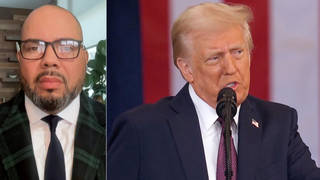
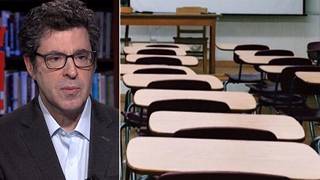
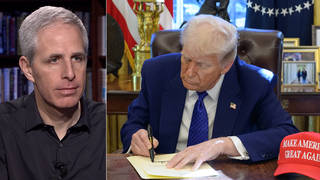
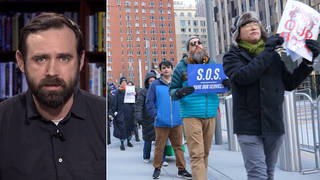

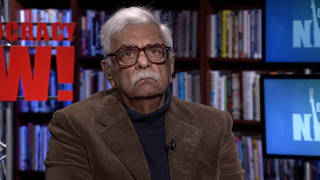
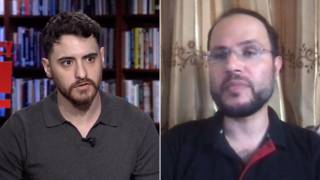


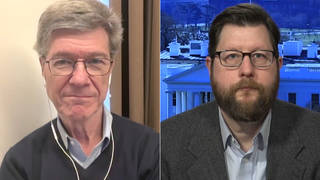
Media Options